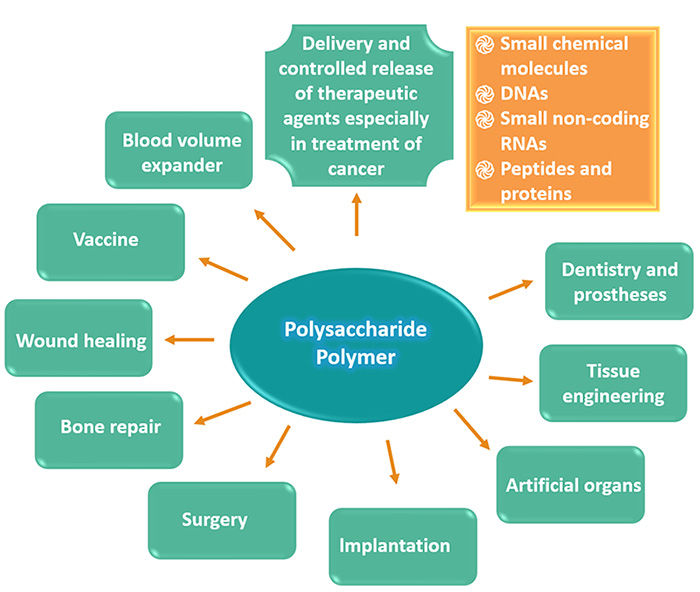Polysaccharide-polymer Conjugation Technologies
Polysaccharides contain different functional groups (such as hydroxyl, amino, carboxylic acid, aldehydes) that make them ideal for conjugation. Polysaccharides are biodegradable, biocompatible, and hydrophilic. Therefore, polysaccharide conjugates have been used in drug, gene and macromolecule delivery, tissue engineering, and other biomedical applications. The advent of nanotechnology, gene therapy, tissue engineering influenced the way these conjugates are now used. Modern day conjugates are modulated to be thermoresponsive, pH responsive, photo-responsive, or target specific (receptor mediated targeting). BOC Sciences is committed to providing our customers with optimal synthesis solutions to custom synthesize high-quality polysaccharide-polymer conjugates, which can accelerate their research in new drugs and new materials.

mg to kg

Open 24 Hours

Crude to >98%

Get Support
Introduction of Polysaccharide-polymer Conjugates
Polysaccharide-based materials represent noteworthy promising delivery vehicles that are easily constructed into different pharmaceutical structures, such as nanoparticles, micelles, nanogel and hydrogels. They can encapsulate APIs with different physicochemical properties. Among several delivery materials evaluated so far, polysaccharides represent very attractive molecules as they can undergo a wide range of chemical modifications and they are biocompatible, biodegradable with low immunogenic properties. Most importantly, polysaccharides are natural polymers with large molecular weight, typically extracted from natural origins such as plants, microorganisms and animals. In comparison to other drug delivery systems (e.g. synthetic polymers), polysaccharide-based polymers remain primarily more attractive, because they are inexpensive, readily available, possibility of numerous chemical modifications and potentially being biodegradable and biocompatible. Due to the origin of polysaccharide-based polymer, they would go through enzymatic degradation leading to the release of body friendly degradation by-products.
| Polysaccharide | Empirical Formula | Building Blocks | Main Sources |
|---|
| Alginate | (C6H8O6)n | Mannuronate, Guluronate | Algae |
| Cellulose | (C6H10O5)n | Glucose | Plants, Algae |
| Chitosan | (C6H11NO4)n | Glucosamine and N-acetyl Glucosamine | Animals |
| Cyclodextrin | C36H60O30 | Glucose | Plants |
| Dextran | H(C6H10O5)xOH | Glucose | Bacteria |
| Hyaluronic Acid | (C14H21NO11)n | Glycosamino Glycan | Animals |
| Pectin | (C6H10O7)n | Galacturonic Acid | Plants |
| Pullulan | C6H12O5)n | Maltotriose | Fungi |
| Xanthan | (C35H49O29)n | Glucose, Mannose, Glucuronic Acid | Bacteria |
Table. 1. Structures and sources of important natural polysaccharide polymers with biomedical applications.
Polysaccharide biopolymers are the natural carbon-based product that could be considered for a wide range of extra modifications. Their polymeric structure consists of repeating monosaccharide units linked by glycosidic bonds. Polysaccharides with awide heterogeneous spectrum of molecular weight, chemical composition, electrical charge and linear or branched structures are applied in pharmaceutical sciences (Table 1). Moreover, since polysaccharides have various functional groups such as hydroxyl, carboxyl and amine, therefore, they show appropriate features for further chemical modifications. The modified polysaccharides can be competent biomaterials in biomedical and pharmaceutical applications. In addition, the hydrophilic functionality of polysaccharides helps to exhibit promising bioadhesion with biological tissues, results in the valuable materials for improving the bioavailability of therapeutic agents, particularly in mucosal/oral drug delivery systems.
Applications of Polysaccharide Conjugates

Our Polysaccharide-polymer Conjugation Services
Chitosan Conjugate

- Low toxicity
- High biocompatibility
- Less side-effects
Hyaluronic Acid Conjugate

- High colloidal stability
- Good biocompatibility
- Cell-targeting ability
β-Cyclodextrin Conjugate

- High drug loading efficiency
- Sustained drug release
- Low cytotoxicity as a drug
Pectin Conjugate

- Excellent stability
- Nano size particles
- High colloidal stability
Dextran/Pullulan Conjugate

- Self-assembly nanoparticles
- Biocompatibility
- Highly uniform size
Alginate Conjugate

- Microparticle self-assembly
- Nanoparticle self-assembly
- Gel self-assembly
References
- Ramezani, M. et al. Anti-cancer drug delivery using carbohydrate-based polymers. Current Pharmaceutical Design. 2017, 23: 6019-6032.
- Domb, A.J. et al. Polysaccharide-nased conjugates for biomedical applications. Bioconjugate Chem. 2015, 26(8): 1396-1412.


















